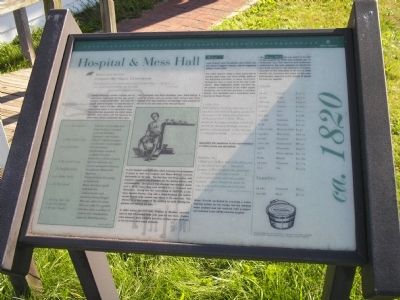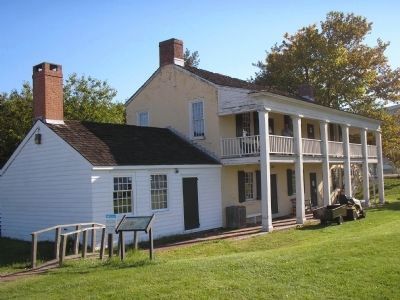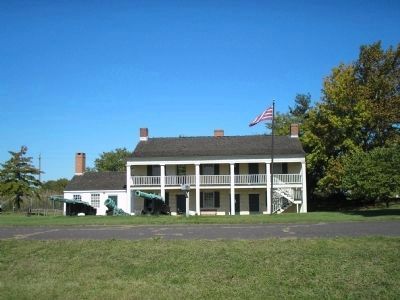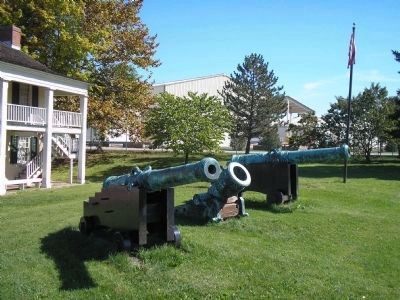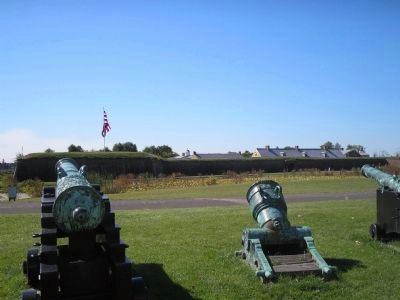Fort Mifflin in Philadelphia in Philadelphia County, Pennsylvania — The American Northeast (Mid-Atlantic)
Hospital & Mess Hall
ca. 1820
Report from the Fort
21 January 1802 • Major J. J. Ulrich Rivardi
Out of the fort is the hospital composed of three small rooms 12 feet by 25, it is a good wooden building, but too small.
Another two-room wooden building and an apothecary shop inside the fort also served medical needs at the time. An order for various medical supplies “to treat the sick at the fort” dated 10 May 1801 probably replenished stock at the apothecary shop. The medicines requested are listed below and have been linked with the ailments for which these natural substances were used.
Also requested were three demijohns, pots, black bottles, 6 yards of muslin, and one double steel spring truss. Such supplies show that medicines and bandages were prepared at the fort to suit the needs of the sick and injured.
A new hospital was built after 1819 following the submission of plans by both the surgeon and Major William Linnard, commander at the time. The first floor had three rooms, with separate entrances and fireplaces for the doctor, matron, and convalescents. The second floor featured two hospital rooms and a third room that was divided for a steward and dispensary. During the fort renovations of 1835-39, a one-room wooden kitchen wing with a large fireplace and built-in stoves to hold large vessels was added at the west end. This allowed for a dual usage of the building for both feeding the garrison and tending the sick.
In 1863 during the Civil War, Surgeon S. Murphey reported that he had 25 hospital beds with room for ten more. Twelve rebel prisoners were patients and nine soldiers were confined to the barracks with slight ailments.
Water
Lack of good water for patients and soldiers was the doctor’s biggest concern, and he suggested piping in fresh water.
The battle against rising or dirty water and to procure clean water was never ending. Wells on the mainland putrified, or were restricted, causing the river or moat to be the only water source. When stagnation, refuse, and privy runoff caused contamination of the water supply, dysentery and diarrhea became a common illness. Two incidents and a resolution were reported by Major Rivardi:
15 July 1801
Every officer in the fort has been more or less attacked with a kind of dysentery ascribed by the surgeon to the bad quality of the water which we are forced to drink. Please … procure for the purpose of making a purifying machine for the use of the troops 500 feet of good two-inch pine plank, 25 feet long and 175 feet of pine boards.
Historical Society of Pennsylvania
Apparently this requisition to the superintendent of military stores was not fulfilled.
November 1801
I drank well water as well as the officer and we now are all laid up … Should the Secretary of War disapprove the expenditure … I shall cheerfully pay it myself … I write in great hurry and with a violent headache – please therefore to excuse the inaccuracies and to believe me with great respect dear sir.
Historical Society of Pennsylvania
Major Rivardi succeeded in creating a water filtering system for his troops, but the drinking water problem was not resolved until a cistern was installed in the 1870s near the hospital.
The Mess Hall that was added to the end of the hospital by 1836 was probably put to immediate use. The laborers and craftsmen contracted by the army engineers to rebuild the fort lived on-site in the quarters available. Accounts for the renovation of the fort in 1836 identify the provisions and costs for the year. Unfortunately statistics on the number of people fed were not supplied.
Foods
38 LBS Flour $416.50
29 LBS Pork $577.50
1807 LBS Sugar $194.27
806 LBS Coffee $108.97
1 Sack Salt $2.37
503 LBS Rice $22.88
712 LBS Codfish $26.73
8 LBS Mackrel $65.45
1 Bu 10 LBS Malt & Hops $4.40
134 QTS Molasses $58.24
31 LBS Saltbeef $392.00
1220 LBS Fresh Beef $85.40
94 BU Potatoes $49.00
511 Pilot Bread $31.29
8 LBS Beans $21.69
79 GALS Vinegar $10.74
10.5
Oil $14.09
Supplies
54 LBS Candles $6.53
132 LBS Soap $7.75
Erected by Fort Mifflin Historic Site.
Topics. This historical marker is listed in these topic lists: Forts and Castles • Notable Buildings. A significant historical date for this entry is January 21, 1802.
Location. 39° 52.579′ N, 75° 12.684′ W. Marker is in Philadelphia, Pennsylvania, in Philadelphia County. It is in Fort Mifflin. Marker is on Fort Mifflin Road, on the left when traveling east. Marker is located outside of Fort Mifflin, near the parking lot. Touch for map. Marker is at or near this postal address: 4800 Fort Mifflin Rd, Philadelphia PA 19153, United States of America. Touch for directions.
Other nearby markers. At least 8 other markers are within walking distance of this marker. Doretta A. McMunn (within shouting distance of this marker); Fort Mifflin (within shouting distance of this marker); From Marsh to Solid Ground (within shouting distance of this marker); Artillery (about 300 feet away, measured in a direct line); Casemates or Bombproofs (about 400 feet away); Main Gate / Flag (about 400 feet away); Fort Mifflin (Mud Fort) on Mud Island (about 400 feet away); Native Plants of Fort Mifflin (about 400 feet away). Touch for a list and map of all markers in Philadelphia.
More about this marker. The marker contains a pictures of a patient with his arm in a splint, and a bucket
of mackerel used to feed the soldiers. There is also a list of medicines used at the fort:
Tincture of Colombo root from Ceylon, a tonic for diarrhea, dysentery and cholera.
Salts of volatile ammonia to reinstate consciousness.
Oil of menthol peppermint, a tropical analgesic for colic, headaches, and local pains.
Spirit of lavender for nausea and gastric distress.
Stoughton’s Bitters for digestion.
Vitriol of ether for croup of diphtheria.
Elixir of white vitriol (sulphur) for conjunctivitis and arresting hemorrhages.
Mercury pills for syphilis.
Glauber salts, a sulfate of sodium for constipation, typhoid, bleeding ulcers.
Related markers. Click here for a list of markers that are related to this marker. This series of markers follow the walking tour of Fort Mifflin.
Also see . . .
1. The Fort that saved America. The Official Website of Fort Mifflin on the Delaware. (Submitted on October 20, 2008, by Bill Coughlin of Woodland Park, New Jersey.)
2. Fort Mifflin Groundplan. Layout of Fort Mifflin, the Fort that saved America. (Submitted on October 20, 2008, by Bill Coughlin of Woodland Park, New Jersey.)
Credits. This page was last revised on February 2, 2023. It was originally submitted on October 20, 2008, by Bill Coughlin of Woodland Park, New Jersey. This page has been viewed 1,132 times since then and 30 times this year. Photos: 1, 2, 3, 4, 5. submitted on October 20, 2008, by Bill Coughlin of Woodland Park, New Jersey.
